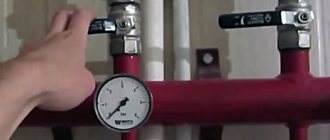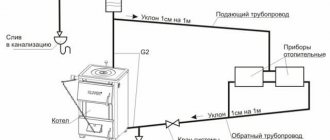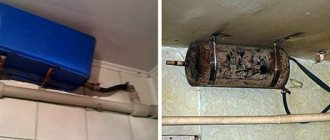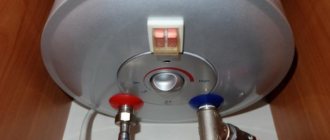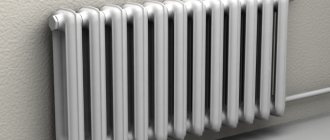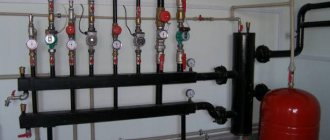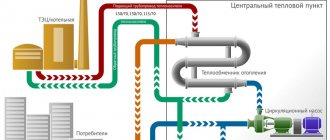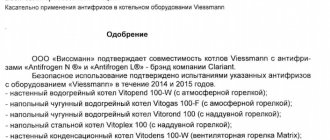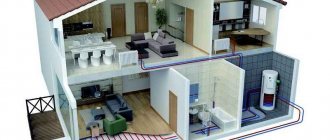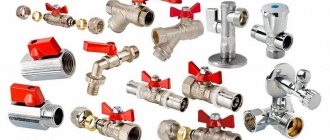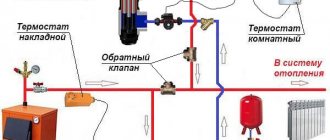Reasons for filling and resetting the system
First of all, you need to figure out in what situations there is a need to drain the coolant from the heating circuit. The first case is obvious - the system must be emptied before repair work. Heating is completely reset when it is necessary to repair and replace shut-off valves, as well as planned and emergency replacements of sections of the main pipeline.
The second case is resetting the system for the whole summer and subsequent replacement of the coolant. The whole problem is that the sealing gaskets located between the sections of cast iron radiators completely lose their elasticity at some point. When there is hot water in the radiator, the sections increase in size and put pressure on the gaskets, but when the temperature drops, due to the decrease in pressure, they begin to leak.
Of course, this phenomenon does not occur immediately - leakage occurs several years after the batteries are put into operation. In most cases, it is not possible to deal with this, since not just one radiator begins to leak, but almost all heating devices connected to the system. To get rid of this problem, the water is drained from the system immediately after the end of the heating season.
This solution has a number of disadvantages:
- When the coolant is poured into the heating system, you will have to get rid of the air that has entered the circuit. Usually this operation is performed by residents of the upper floors, but in their absence it will be impossible to eliminate air jams. If there is a bottom spill, this problem can be solved by switching the riser to reset mode, but in other cases it will be difficult to solve the problem.
- It is impossible to remove all moisture from the heating circuit, and in combination with air it greatly accelerates the process of battery corrosion. Obviously, all this leads to a decrease in the service life of heating devices and the entire system.
To understand why it is necessary to constantly fill a closed heating system of private houses with coolant, it is worth starting from two factors:
- Material for making pipes and batteries. If the system uses elements made of ferrous metal, then it is extremely undesirable to drain the circuit for a long time. It’s another matter if the house has aluminum radiators and polymer pipes - these materials are completely resistant to corrosion, so the lack of coolant in the system will not harm them in any way.
- The total volume of coolant in the system. It is simply unprofitable to drain water from a system that has a large volume - in private houses you have to pay for water according to the meter. However, this factor is rarely decisive, since in most cases the volume of coolant required for heating is not so large that its impact on costs becomes noticeable.
Who can you trust to heat your home?
If you are planning to heat your home , then immediately contact our company for these types of work. The company’s specialists will go to the site, make a project, and help you select the appropriate equipment. A more economical option is to connect the system autonomously. If necessary, you can turn the boiler on or off at any time.
| Monday | Open 24 hours |
| Tuesday | Open 24 hours |
| Wednesday | Open 24 hours |
| Thursday | Open 24 hours |
| Friday | Open 24 hours Now open |
| Saturday | Open 24 hours |
| Sunday | Open 24 hours |
Starting the heating of an apartment building
In a multi-storey building with bottom filling, the heating system is started as follows:
- When the supply is closed and the return is closed, the discharge of the supply pipeline opens;
- The return valve opens very smoothly. A sudden opening of the valve will most likely lead to water hammer, which can seriously damage the radiators, even to the point of rupture;
- After some time, water without air will come out of the discharge. When this happens, the discharge closes and the supply pipeline valve opens;
- All that remains is to bleed the air from all parts of the system where this is possible.
In a house with a top fill, starting is much simpler: you just need to open two valves with the discharges closed, get to the top air valve located on the expansion tank, and bleed the air.
How to start an open gravity heating system
There are no particular difficulties with open systems. Filling the heating system with coolant in this case is very simple: just pour a certain amount of water directly into the expansion tank. When water appears at the bottom of the tank, you need to stop pouring it. You should not be overly zealous with the amount of water - during thermal expansion, its excess will pour out through the tank.
If the system was assembled only recently, and the heating system is being filled with coolant for the first time, then it is also worth conducting a leak test. To do this, it is enough to inspect all connections of pipelines and radiators.
How to replace the coolant in the heating system of different heating systems
Contents:
Reasons for filling and resetting the system Starting the heating of an apartment building How to start an open gravity heating system Filling and starting a closed heating system Calculating the volume of coolant Conclusion
When installing a heating system and repairing it, sooner or later it becomes necessary to fill the circuit with coolant. In addition, sometimes you have to perform the reverse operation, i.e. drain the coolant. Different situations arise, and there are a number of factors, depending on which filling the system with water can be performed in different ways. How to replace the coolant in the heating system will be discussed in this article.
Filling and starting a closed heating system
A heating system with forced circulation of coolant has a couple of key features:
- When operating a system equipped with a heating boiler and a circulation pump, a pressure exceeding atmospheric pressure always occurs.
- Before putting the system into operation, the system undergoes pressure testing, at which the pressure value exceeds the operating pressure by one and a half times. Pressure testing is especially important for heated floors that are laid in a screed. It is important that the pressure testing of the heated floor is carried out by a specialist.
Before pouring coolant into a closed heating system, you need to take these factors into account and consider the technology for carrying out the work.
In buildings with central water supply, the problem with pressure testing is solved in a very simple way. To do this, the heating is connected to the water supply via a jumper and is filled with constant monitoring of the pressure using a pressure gauge. When the system is pressurized and checked for leaks, excess water is drained through a valve or air valve.
It’s a completely different matter if water is poured into the heating circuit manually, or if various types of antifreeze compounds are used as a coolant. Before pouring coolant into a closed heating system, in most cases it is enough to take a pump that allows you to fill the coolant and pressurize the circuit. The pump is connected via a valve, which closes when the required pressure is reached.
However, the system can be filled without a pump. To pump 1.5 atmospheres into the system, you can take advantage of the fact that this value corresponds to 15 meters of water column. Given this knowledge, before filling a closed heating system with coolant, you can solve the problem in the simplest way - connect a reinforced hose to the discharge valve, raise it to a height of 15 meters and fill it with water.
Replacing the coolant in the heating system of a country house can be done using an expansion tank. This element is designed to receive excess liquid during thermal expansion. A membrane tank is a structure in which there are two cavities separated by a movable membrane. One part of the tank receives the coolant, and the second contains air. Also, any tank is equipped with a nipple, with which you can increase or decrease the air pressure.
Filling the heating system with water using a tank is carried out as follows:
- First, all air is completely removed from the tank, for which you simply need to unscrew the nipple. The pressure in standard tanks is 1.5 atmospheres.
- Water is poured into the system. It is not necessary to completely fill the tank - the volume of air should be about 1/10 of the total volume of coolant in the system.
- Air is pumped into the tank using any hand pump. The pressure is constantly monitored by a pressure gauge.
How to add water to a closed heating system
Preparation
Regardless of whether a new, just installed system is being launched, or the circuit has been reset for repair or replacement of coolant, the utility network must undergo certain preparation before filling:
- Drain. Before pouring new coolant into the system, the old one must be completely drained. To do this, turn off the boiler and wait until the water temperature drops to room temperature. Next, by opening the drain valve at the bottom of the heating circuit, drain all the liquid: it must be collected in special containers for subsequent disposal. After waiting until the system is completely emptied, open the Mayevsky valve at its top point - this will allow the pressure in the pipes to stabilize.
Mayevsky crane
- Flushing. It is necessary to remove all debris from inside the circuit - chips, scale, limescale, etc. This is done using a pump connected to the network, which pumps the washing solution inside. It often takes several cycles until the water comes out completely clean. The water for the last rinse is enriched with neutralizers to remove additives in the first portions.
Flushing the heating system
- Pressing. It allows you to test how tight all joints and connections of the system are before filling in the coolant. To do this, create excess pressure inside the circuit by pumping air or using a coolant. To carry out the test, you will need a mechanical (electric) pump. There is also an option to connect the water supply, but this kind of procedure is much more difficult. Before connecting the pump to the inlet pipe of the system, you must carefully inspect all joints and connecting nodes. If no defects were found, excess pressure is created inside the circuit (the norm must be exceeded by 1.5 times).
Manual pressure test pump
- Elimination of leaks. All leaks discovered during pressing must be eliminated. If the flaw is at the junction, then it is repacked, installing a new seal. Leaks in the middle of the pipe are solved by replacing the damaged section.
Before pouring water into the heating system, it is necessary to eliminate all leaks
- Checking the complete set. Before filling a closed heating system with water, it must be checked for the presence of the necessary safety equipment. We are talking primarily about Mayevsky taps, bypasses, thermometers and pressure gauges. If any of these elements are missing, it will most likely cause problems with the heating.
Calculation of coolant volume
In cases where water not from a pipeline is used as a coolant, it is important to know exactly how much liquid is needed.
This can be determined in the following ways:
- When resetting the system, measure the drained liquid using a meter or a special container of known volume. The same method can be applied when flushing and pressing the circuit.
- Separately summarize the volume of elements included in the system. The parameters of the boiler, batteries and expansion tank are indicated in the passport documentation for these products, and the volume of the pipeline is determined using special tables from the plumbing reference book.
Thread diameter, inch Conditional bore, mm Volume, liter 1/2 15 0,177 3/4 20 0,314 1 25 0,491 1 1/4 32 0,804 1 1/2 40 1,257 2 50 2, 467 2 1/2 65 3, 318 3 80 5,026 4 100 7, 854 The volume of coolant in one meter of pipe
Filling a closed heating system
Having prepared the required amount of coolant, you can begin filling the pre-washed and tested system. The most convenient way to do this is with a vibration pump.
Given the particular importance of this procedure, care will be required when performing it:
- All joints are checked for defects and leaks for the last time.
- Shut off the shut-off valves through which coolant is removed from the heating circuit. This is done to avoid unnecessary fluid loss.
- Test to see if the air valves are working properly. If it turns out that their level of performance is insufficient, it is recommended to fully open the Mayevsky tap during the entire filling procedure. You can also leave the valve open in the upper section of the network, which will significantly speed up the release of air accumulated in the pipes.
Heating system elements
- Begin to pour water through the pipes adjacent to the boiler. In this case, it is advisable to supply the liquid as slowly as possible: in this case, the internal air can be easily discharged through the open fittings. Rushing at this stage usually leads to traffic jams. To avoid water hammer, the tap on the pipe through which water is supplied should be opened no more than halfway.
- As the circuit is filled, all taps and valves from which liquid begins to splash are closed: before starting the process, it is advisable to place an empty basin or bucket near each of them. For this reason, water is stored with a certain reserve, taking into account possible losses.
- When pouring water, it is recommended to change the position of the pump from time to time, switching to higher outlets. This is especially true for filling a closed system in houses with several floors.
- Checking the quality of the filling. To fill the amount of coolant, it is recommended to determine not only the total figure, but also the volume of individual sections of the circuit. This will allow for quality control of filling as it progresses using meters on the inlet pipes. This will allow you to monitor the amount of coolant already pumped in, comparing it with the volume of individual elements of the system. If, after filling a certain area, it turns out that less liquid was used than was calculated, it means that an air lock has formed inside. If the filled volume of coolant exceeds the calculated data, you need to look for the location of the leak.
- Draining excess air. Upon completion of the filling procedure of a closed system, all air must be removed from it. The main pipe is deaerated using an air valve, which is usually located on the boiler. If the circuit uses a forced coolant circulation method, then air is bled from the pumping equipment using an air valve, which is usually located in front of the device.
Automatic air release and air release using a Mayevsky crane
Each radiator must also be freed from air pockets individually, starting with the heating elements on the ground floor. This procedure is very simple: using a key or screwdriver, open the Mayevsky tap, closing it only after water appears in the hole. Finally, you need to check the return flow using the valves installed on it. Having released all the air, the pressure in the closed system must be brought to 1.5 atm, and only then shut off the water supply.
Feeding the system
To ensure efficient operation of a closed heating circuit, the pressure in it must be kept at a constant level. This is directly affected by the volume of coolant circulating through the pipes and radiators. In any case, it will gradually leak out, despite the high level of tightness of the system: replenishment of liquid will be required to make up for these losses. The issue is solved by special make-up valves, which are equipped in areas of the circuit with the lowest pressure (most often, next to the pump, directly in front of it).
Make-up valve
Small houses with low-power heating systems are usually equipped with mechanical valves. In this scheme, compensation for pressure surges occurs thanks to the rubber membrane of the tank. To avoid emergency situations, you have to constantly monitor pressure parameters.
Automatic filling
Double-circuit boilers, as a rule, have a device for automatically filling the coolant. This electronic control unit is installed on the inlet pipe. The convenience of this solution lies in the fully automatic regulation of pressure in the system through timely pumping of liquid.
If the pressure in the network is critically low, a signal from the pressure gauge is sent to the control unit. This, in turn, activates the supply valve, which begins to allow water to flow into the system until the pressure is completely stabilized. However, you have to pay for convenience, which is reflected in the high cost of automatic filling devices.
Calculation of coolant volume
Residents of apartment buildings do not need to know about the volume of coolant in the system, but in private houses this knowledge is very important:
- Firstly, the expansion tank is selected depending on the volume of the heating system. Exceeding the required dimensions does not threaten anything special, but a tank that is too small will lead to constant overflow of coolant, and it will have to be topped up regularly.
- Secondly, in country houses it is very difficult to maintain a stable heating temperature, and when using solid fuel boilers it is impossible. It is impossible to leave the heating system in a full state during frosts, so the only solution to the problem will be non-freezing coolants. Since their cost directly depends on the volume of coolant, you also need to know the volume of the system.
There are two ways to determine the volume of the heating system without using complex calculation methods and regulatory documents:
- The first method is possible if, before refueling a closed-type heating system, a connection to the water supply is established through a jumper. A completely empty circuit (without coolant and air) is filled with water with the taps and valves closed. The amount of water spent on filling the heating system can be determined by a meter installed on the water supply system.
- The second method is to reset the system through the appropriate valve and place any container whose volume is known under the spilling water. When measuring the coolant volume in this way, you need to open the vents on each heating device so that water does not remain in them and lead to measurement errors.
Recommendations for use
It is not allowed to use antifreeze in a heating system with galvanized pipes. The result of the chemical reaction of the coolant with the metal is insoluble sediments that clog the pipes.
It is not recommended to mix antifreezes not only of different purposes, but also of brands, as this can lead to a decrease in the performance of the coolant, as well as the formation of rust inside pipes and batteries. In some cases, such mixing is possible, but only after testing for their compatibility.
Expansion tank for liquid in the heating system
It is recommended to dilute antifreeze with soft distilled water without metal salts. If ordinary tap water is added to the heating network, insoluble residues may form. The water hardness indicator should be no more than 5 units. The dilution ratio of concentrated antifreeze with water is 1 to 2.
Before filling the heating system with antifreeze, you should make sure that the pumps and batteries have sufficient power, because, for example, ethylene glycol antifreeze has a heat capacity 15-20% lower than water.
Before changing the traditional coolant to a frost-resistant one, it is recommended to increase the capacity of the expansion tank or replace it with a larger one. The volume of the tank must be at least 15% of the total volume of liquid in the heating system.
For the effective use of antifreeze in a heating system, the most important condition is to ensure its tightness. In open systems, the use of antifreeze does not achieve a significant effect.
